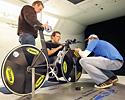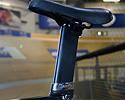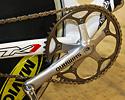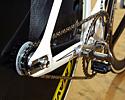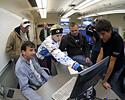
Recently on Cyclingnews.com |
Pro bikes, January 30, 2008
Sarah Hammer's Felt TK1
A new hammer for HammerBy James Huang Track rider Sarah Hammer is one of the United States' best hopefuls for a gold medal at the upcoming Summer Olympics in Beijing this August. Hammer began competing when she was just eight years old; 16 years later at the age of 24 she now finds herself the reigning two-time World Pursuit Champion after successfully defending her title in Palma de Mallorca, has won over half a dozen World Cup events, and also holds twenty US National titles on the track. Hammer has competed on Look and BT machines in the past but switched her bike sponsorship earlier this year to Felt Bicycles. In many ways it was a natural fit: Felt's headquarters is only an hour away from Hammer's residence in Temecula (barring typical SoCal traffic, of course) and roughly marks the halfway point on the way to her training grounds at the ADT Event Center. Moreover, Felt is also the official bike sponsor of the venue. As good as Felt's extant TK2 aluminum track machine probably already was, a rider of Hammer's stature clearly warranted something special and development work on a new carbon bike started almost immediately after the sponsorship deal was announced. "We started talking to her in about March or April and that's about the time that we sat down to talk about geometry and the kinds of shapes we wanted to use," said Ty Buckenberger, Felt's lead engineer on the project. The new bike, officially dubbed the TK1, was publicly unveiled at the UCI World Cup event in Los Angeles, California, earlier this month. At least in general terms, its new slippery form bears a strong resemblance to Felt's TT/Tri-specific DA whose lines were carefully crafted using both computational fluid dynamics software and countless hours in San Diego's Low Speed Wind Tunnel. "We looked at a lot of the bikes that are considered 'the top' to the track guys right now, and to us, from what we learned from the DA, many of them don't actually have any real aero shapes to them," Buckenberger continued. "So we wanted to try to use that aero shape as much as possible. We learned about different areas on the bike with the DA when we did wind tunnel testing and this bike is almost the next evolution of that bike. "If you see the DA and track bike side-by-side, you can see the aero shapes are taken one step further from the DA. We wanted to develop that even more on the track bike. Sarah's event, time-wise, is fairly short so we wanted to get it as aero as possible to save her every little bit. We paid a lot of attention to that kind of stuff." Felt's prior work on its successful DA also netted benefits in terms of development time. According to Buckenberger, "[The work we had already done on the DA] definitely helped. We knew what worked and what areas we needed to pay attention to. That bike was really the only thing I worked on for that whole time, too. There weren't any other projects in there so it was just that thing. I sent the final drawings for that bike to the factory in the middle-to-end of July and then we saw the first one for Sarah in around October." Unlike match sprinters, though, Hammer's pursuit specialty doesn't necessarily dictate an uber-rigid frame. Other than aerodynamics, frame geometry and handling characteristics were apparently her main concerns. "The main thing she really wanted was a bike that was stable for her type of event," said Buckenberger. "Before, she couldn't really hold her line on the track very well; she'd do this sort of 'lazy S' along the track trying to hold the line. Being a pursuit rider, too, she wasn't necessarily concerned with stiffness. The bike didn't need to be sprinter-stiff for her. The geometry and aerodynamics were what she was looking for." Hammer was apparently happy with the result, saying, "Besides the striking beauty of the bike, the first two things I noticed were the stiffness of the bike and how well it tracked in the corners. The first standing start I did I was amazed at the difference compared to other high-end track bikes I've ridden. With this bike Felt has squarely set themselves at the top of the track market. It cannot get any better than this! And when I'm lining up in Beijing in August, that will really count." Felt's wind tunnel testing suggests that Hammer's new bike should net her four-tenths of a second advantage over her previous setups, which is a particularly substantial chunk of time when you consider that her events typically only last about 3 1/2 minutes. Hammer posted a blazing 51.097 km/h average speed during her last world pursuit title win; a 0.4s gain would have equated to 5.68 meters of additional real estate. Some of her competition would undoubtedly like to get their hands on that sort of advantage for themselves prior to this summer's games and Felt does plan to offer the TK1 as a production model… but not until after Beijing. Wisely, Hammer and Felt would prefer to keep that trump card to themselves for the time being but that apparently hasn't kept some riders and teams from asking anyway. "We've had a ton of interest in it already. The Korean guys have been calling our marketing guy, the New Zealand guys are bugging us… a lot of teams are interested in it," said Buckenberger. Current estimated frame weight is roughly 1800g, which Buckenberger admits is probably overkill for Hammer. "We have a couple of the Slipstream guys and Taylor Phinney on one, and we also have US National Sprint Champion Michael Blatchford on one, too. It's stiff enough for him so it's probably overbuilt for Sarah," he said. Ultimately, Felt may decide to offer the TK1 in two stiffness levels to suit particular needs and desires, much like what it already does with its road-going F1. According to Buckenberger, lighter riders and pursuiters could possibly use an identically-shaped frame weighing as little as 1300g. Watch out, Beijing; the Hammer is coming! PhotographyFor a thumbnail gallery of these images, click here Images by Mitch Clinton/www.clintonphoto.com
Images by Felt Bicycles
Images by Mitch Clinton/www.clintonphoto.com
| |||||
Full specificationFrame: Felt TK1 Critical measurements Bottom bracket: Shimano Dura-Ace BB-7700 |
Front wheel: Mavic iO Bars: Oval Concepts A901 Laminar Carbon, 42cm (c-c) Pedals: Shimano Dura-Ace SPD-SL PD-7810 Total bike weight: (17.25lb) (estimated) | ||||


